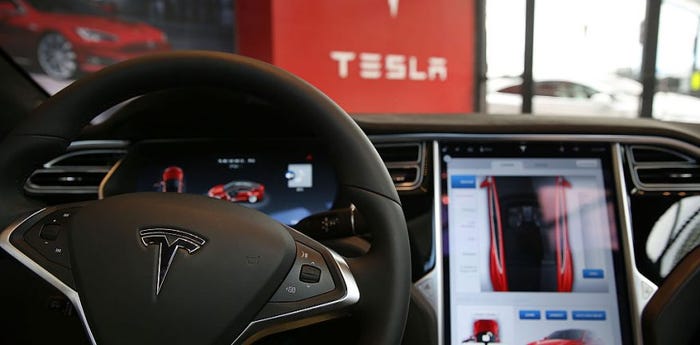IoT in Logistics: Edge vs. Cloud Computing Analytics
When it comes to logistics analytics, which is best for connectivity: edge computing, cloud computing or a mix of the two?
August 8, 2019

The Internet of Things is giving the trucking and logistics industry the visibility it needs to improve efficiency and safety. However, like any technology, IoT deployment decisions must be driven by a cost-benefit analysis. That includes the decision of which analytics types should be at the edge or in the cloud.
Sensors in an IoT deployment can generate reams of data, and that data has to go somewhere to be analyzed. “You can send the data to a cloud instance or a centralized on-premises data center, but that requires data transmission, and when you’re looking at the transportation industry, there are a lot of areas where data transmission over cellular or satellite becomes prohibitively expensive or the connectivity just isn’t there,” explained Sean Riley, global industry director for manufacturing & transportation at Software AG.
Connectivity is a pretty black and white issue — either you have it, or you don’t. Cost is a little more nuanced. Organizations should consider how much data their devices generate.
“If devices are sending redundant information, it doesn’t make sense to continually send that to the cloud. It will eat up your cellular bill,” said Suneil Sastri director of product management at SOTI. “That’s the general challenge with IoT. If you look globally, we’re looking at 75 billion endpoints by 2025 that will create somewhere around 163 zettabytes of stored data. It’s really critical for organizations to rein that in so that they’re not experiencing costs in respect to storing and transmitting that data,” he said.
The edge can help relieve some of those costs, whether the use case is monitoring cargo temperature to maintain the integrity of the cold chain, assessing cargo space to minimize the transportation of dead space, or detecting wear and tear on the vehicle to improve truck maintenance.
Thin Edge vs. Thick Edge
When it comes to the edge itself, some experts differentiate between the thin versus thick edge. The thick edge, Riley explained, is when compute is performed on a server that’s on the transportation asset. “It can do more than the thin edge because it has significantly more computing power,” he said.
However, the thick edge also requires more physical space. “You won’t put a server on a truck. But if you’re talking about container shipping, there’s plenty of room on the freight liner to put a server somewhere in there,” Riley said.
The thin edge is used for the majority of IoT use cases in trucking. In this scenario, a computing device or “gateway” sits on the truck or another asset. Instead of sending data directly over a cellular network, the sensors send all data to this device. “A compute device aggregates data from the different endpoints, computes the data and performs tasks such as machine learning or artificial intelligence, and in a much faster, almost real-time way compared to what the cloud is able to do because it is closer to where the data is being generated,” said Michael Schallehn, partner and IoT expert, Bain & Company.Difficulties still have to be overcome when analyzing data at the edge. Whether the gateway is running simple threshold rules or a predictive model, organizations need a way to deploy and manage the analytics. “To be able to do that without it becoming an arduous task, you need to be able to access the gateway remotely as well as deploy those models in a structured, automated manner,” Riley said. “Deploying that many predictive models to the edge without automation is a cumbersome task requiring dedicated staff.” For a regional provider with 150–250 trucking assets, the lack of automation could tip the cost-benefit equation in an unfavorable direction, he said.
Going to the Cloud
Just because a use case leverages the edge, doesn’t mean that the cloud is out of the picture. According to Riley, sending the data to the thin edge reduces data transmission to the cloud by 99.8%, enabling organizations to economically leverage the cloud for more advanced use cases.
“When you use the thin edge, you always use the cloud or an on-prem central datacenter. You want to get a hold of all that data that is on the edge device because predictive models take care and feeding, and they have to be changed over time because of the refinement of them or changes in the operating parameters of the pieces of equipment that are being used. You want to obtain that data so that you can change those parameters or perform prescriptive analytics,” Riley said.
The cloud offers efficiency of scale as well as advanced capabilities needed to perform these tasks. “There are much better capabilities to extract insights out of the data in the cloud. A lot of the machine learning today takes place in the cloud, and all the training is happening in the cloud,” Schallehn said.
“Many organizations are moving a lot of business workloads to the cloud because cloud computing becomes a workhorse for those organizations to analyze vast amounts of data, to gather insights from the data, do some form of machine learning and act on that data and send to relevant devices or apps that the organization is using. So, cloud computing does play a critical role in organizations getting the maximum benefit of their IoT,” Sastri said.
About the Author(s)
You May Also Like

.png?width=700&auto=webp&quality=80&disable=upscale)
.png?width=700&auto=webp&quality=80&disable=upscale)
.png?width=300&auto=webp&quality=80&disable=upscale)
.png?width=300&auto=webp&quality=80&disable=upscale)
.png?width=300&auto=webp&quality=80&disable=upscale)
